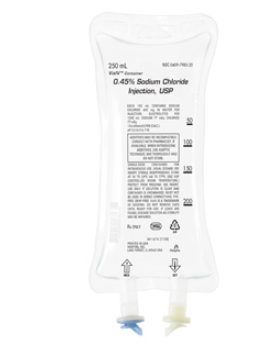
0.45% w/v SODIUM CHLORIDE INJECTION, USP [Medisal] Price
Active Substance: Sodium chloride.
Overview
Welcome to Dwaey, specifically on 0.45% w/v SODIUM CHLORIDE INJECTION, USP [Medisal] page.
This medicine contains an important and useful components, as it consists of
Sodium chlorideis available in the market in concentration
Name
Sodium chloride
Precaution
<ul> <li>Use with caution in patients with heart failure, renal impairment, or liver disease due to the risk of fluid overload and electrolyte imbalance.</li> <li>Monitor serum electrolytes and fluid balance regularly during prolonged administration.</li> <li>Administer with caution in elderly patients who may have reduced renal function or are on medications affecting electrolyte balance.</li> <li>Avoid excessive infusion rates to reduce the risk of pulmonary edema or hyponatremia.</li> <li>Do not use if the solution is discolored or contains particulate matter.</li> </ul>
Indication
<ul> <li>Maintenance or replacement of fluid and electrolytes in patients with dehydration or electrolyte imbalance.</li> <li>Used in pediatric and adult patients who require hypotonic saline for hydration purposes.</li> <li>Adjunct in the treatment of metabolic alkalosis in the presence of fluid loss.</li> <li>Vehicle for the administration of compatible intravenous drugs.</li> </ul>
Contra indication
<ul> <li>Severe renal impairment with oliguria or anuria where fluid overload is a concern.</li> <li>Congestive heart failure or severe hypertension without close monitoring.</li> <li>Hypernatremia or fluid retention disorders such as cirrhosis with ascites or generalized edema.</li> <li>Conditions where sodium retention could be clinically detrimental.</li> </ul>
Side Effect
<ul> <li>Local reactions: pain, swelling, or irritation at the injection site.</li> <li>Fluid overload leading to pulmonary edema or peripheral edema.</li> <li>Electrolyte imbalance, including hypernatremia or dilutional hyponatremia.</li> <li>Acid-base disturbances in prolonged or high-dose administration.</li> <li>Rare: febrile response or infection due to contamination during administration.</li> </ul>
Pregnancy Category ID
Information not available
Mode of Action
<ul> <li>Sodium chloride dissociates into sodium (Na⁺) and chloride (Cl⁻) ions in solution.</li> <li>The sodium ion helps regulate extracellular fluid volume and maintains nerve impulse transmission and muscle function.</li> <li>The chloride ion plays a role in maintaining acid-base balance and osmotic pressure.</li> <li>This hypotonic solution provides free water and a lower sodium content, which assists in correcting hypertonic dehydration and intracellular fluid deficits.</li> </ul>
Interaction
<ul> <li><strong>Diuretics:</strong> May affect electrolyte levels, especially when used with sodium-containing fluids.</li> <li><strong>Corticosteroids:</strong> May cause sodium retention and fluid overload when used concurrently.</li> <li><strong>ACE Inhibitors/ARBs:</strong> May increase the risk of hyperkalemia and renal dysfunction when combined with large volumes of saline.</li> <li><strong>Potassium-sparing diuretics:</strong> Risk of electrolyte disturbances if administered without monitoring.</li> </ul>
Pregnancy Category Note
<ul> <li>Pregnancy Category: <strong>Not assigned (considered safe)</strong>.</li> <li>Sodium chloride solutions are generally considered safe during pregnancy when used appropriately under medical supervision.</li> <li>No known teratogenic or embryotoxic effects have been reported.</li> <li>Care should be taken to avoid fluid overload in pregnant women with preeclampsia or other cardiovascular concerns.</li> </ul>
Adult Dose
<ul> <li>The typical adult dose varies depending on the patient's fluid and electrolyte needs.</li> <li><strong>Maintenance Fluid:</strong> 1000–2000 mL per day or as directed by a physician based on clinical status.</li> <li>Adjust the rate based on age, weight, and clinical condition.</li> <li>Usual infusion rate: 50–100 mL/hour; in acute settings, rates may be higher under monitoring.</li> </ul>
Child Dose
<ul> <li><strong>Maintenance Requirement:</strong> Based on the Holliday-Segar method or clinical judgment.</li> <li>Daily requirement: <ul> <li>100 mL/kg for the first 10 kg</li> <li>50 mL/kg for the next 10 kg</li> <li>20 mL/kg for weight above 20 kg</li> </ul> </li> <li>Adjust infusion rate based on hydration status, electrolyte levels, and ongoing losses.</li> </ul>
Renal Dose
<ul> <li>Use with caution in patients with renal impairment due to risk of fluid overload and electrolyte imbalance.</li> <li>In patients with oliguria or anuria, avoid or restrict sodium chloride infusion unless absolutely necessary.</li> <li>Frequent monitoring of serum electrolytes, fluid status, and renal function is mandatory.</li> <li>Dose adjustments and slower infusion rates are recommended under nephrologist supervision.</li> </ul>
Administration
<ul> <li>Administer by intravenous infusion using aseptic technique.</li> <li>Inspect the solution before use—do not use if discolored or cloudy or if particulate matter is visible.</li> <li>Do not add medications without ensuring compatibility.</li> <li>Infusion should be regulated using a volumetric pump or drip controller to avoid overhydration.</li> <li>Use with appropriate venous access device and monitor infusion site regularly for signs of phlebitis or extravasation.</li> <li>Do not administer subcutaneously or intramuscularly.</li> </ul>
